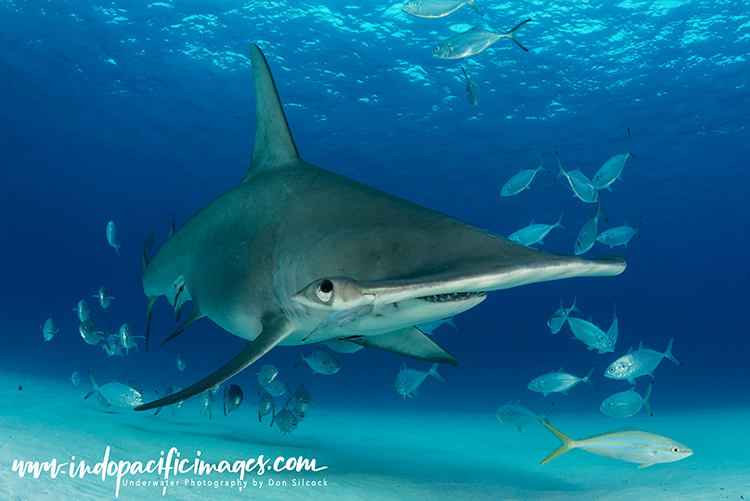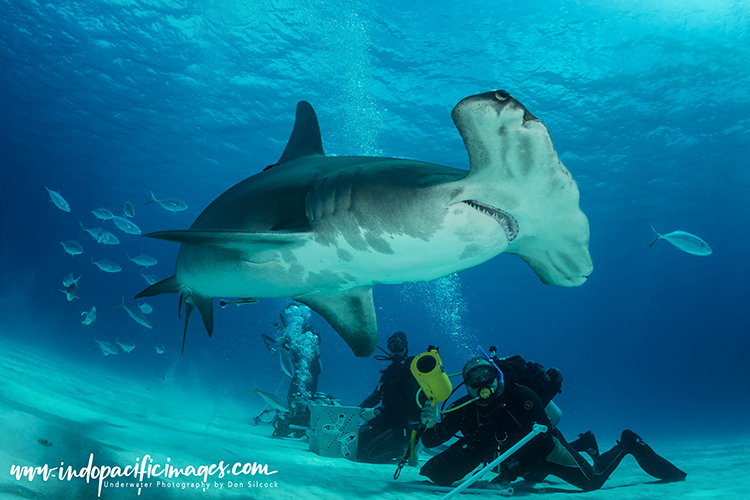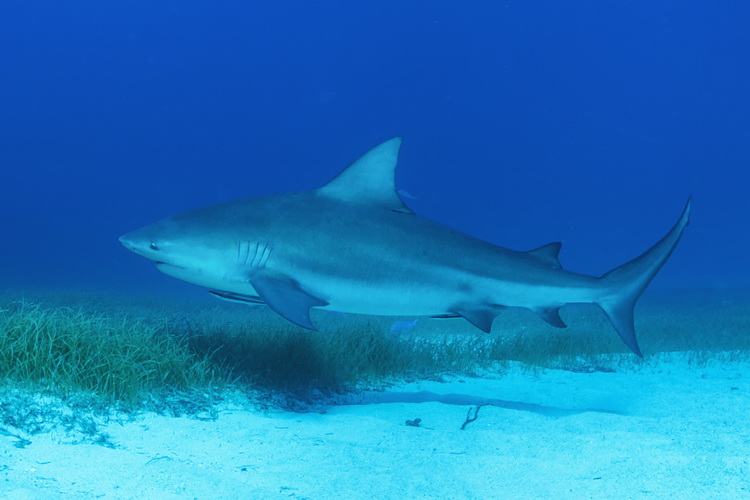The Great Hammerhead sharks of Bimini really are very special… There is literally nowhere else in the world where you can come face-to-face with these incredible animals so reliably. Large, increasingly rare and generally solitary animals – Great Hammerheads are really difficult to see underwater.
When underwater encounters do happen they are typically fleeting at best, but not in Bimini! Where every winter a healthy population of Great Hammerheads gathers just off the coast of the island.

Great Hammerhead Sharks of Bimini – Discovery
The annual aggregation of Great Hammerheads was discovered by the staff of Dr Samuel Gruber’s Bimini Shark Lab back in 2002… But the lab managed to keep the whole thing to themselves for over 10 years. However word eventually got out and South Bimini is now firmly established as Great Hammerhead Central!
So unique is the situation that trips get booked up very quickly… Personally it took me two attempts and a one-year advance booking to do mine.

Great Hammerhead Sharks of Bimini – Why There?
The Bahamas are said to take their name from Baja Mar – the Spanish term for “shallow seas”. That’s because the archipelago resides on top of two main limestone carbonate platforms called the Bahama Banks.
Great Bahama Bank covers the southern part of the archipelago. While Little Bahama Bank covers the northern part. With incredible channels as deep as 4000m separating the two.
The small islands of North and South Bimini sit at the north-western tip of the Great Bahama Bank. Isolated from the rest of the archipelago and physically closer to Miami than the nearest Bahamian city of Freeport.


Their location means that to the north, south and east is the shallow water of the Great Bahama Bank.
Which is typically some 10 to 15 meters in depth – hence the “shallow seas”…
While to the west is shallow water that slopes down to about 50m.
And then plunges down in to the 2000m deep channel between Miami and Bimini.
Through that channel flows the rich waters of the Gulf Stream as it heads north towards the Atlantic Ocean.
Great Hammerhead Sharks of Bimini – The Gulf Stream
The Gulf Stream is a profoundly important force of nature. Conceptually it can be thought of as almost a conveyor belt of warm, fertile and nutrient-laden water. And, as it flows up from the Gulf of Mexico, it sweeps up eggs and larvae along the way.
Those eggs and larvae thrive in the rich current, before being deposited at landfalls along the way. With the islands of Bimini being the first major way-point.
Bimini is uniquely placed to benefit from that life-flow because of its large areas of mangroves and sea-grass. Which provide the eggs and larvae the nursery they need to grow into crabs, lobsters and conch. In turn providing a source of food for the animals higher in the marine food chain such as stingrays and sharks.

Great Hammerhead Sharks of Bimini – Marine Parks
The Bahamas has never really been at the leading edge of the conservation movement. And it has to be said that the country has suffered from over-exploitation of fish stocks plus periodic over-development of tourist resorts in ecologically sensitive areas.
But, on the other hand… it was the first country in the Caribbean to create a marine protected area. The 112,640 acre Exuma Cays Land & Sea Park. Established in 1959 under the newly-formed Bahamas National Trust. Which, with the benefit of 20/20 hindsight, was truly an incredible piece of foresight!
The Bahamas have since added another 26 national parks covering over 1 million acres of land and sea. Together with enacting substantial supporting environmental legislation, including making Exuma Cays a no-take marine reserve.
Then in 2011 the government went one step further. Becoming the 4th country in the world to establish a shark sanctuary by formally protected all sharks in Bahamian waters. All of which has created an incredibly important sanctuary for animals like the Great Hammerhead, Tiger Sharks and Oceanic Whitetips!

Great Hammerhead Sharks of Bimini – Face to Face…
Hammerheads are regarded as aggressive hunters that feed on smaller fish, octopus, squid and crustaceans. But they are not known to attack humans unless provoked. In Bimini they are tempted in close by feeding them. And the whole thing is carefully organized to give the participants maximum exposure to the animals.
Which is done by limiting the number of people in the water at any time to six participants. Plus one “feeder” and a safety diver watching your backs.

The feeder is in the middle with an aluminum bait box (to keep the sharks from getting over excited…). There are three participants on either side who rotate positions after 15 minutes. So that everybody gets a turn next to the bait box where it can get very exciting!
There are usually 12 people on a trip, so after 45 minutes you get a tap on the shoulder. Which means it’s time to give up your place and return to the boat. The safety diver is there not because of the hammerheads that often roam around behind you. But because of the Bull Sharks that are also quite common in Bimini…

All this is in about 12m of water, so air consumption is minimal and deco is not really an issue. Basically the show goes on all day… But interestingly the first hammerheads only show up about ten in the morning – so it’s a leisurely start every day.
Great Hammerhead Sharks of Bimini – Feeding Time!
The job of distributing the pieces of fish on any shark feed is clearly somewhat of a fairly high-risk endeavor. But with the Great Hammerheads it takes on quite another dimension!
As the shark approaches the feeder it can see the offered bait. Then, at the last minute, the feeder flicks the bait slightly to the left or the right. So that the participant at that side will get an up-close and very personal photo-opportunity.

The shark sees where the bait goes and turns… But at that point the bait usually disappears under its mallet-shaped head. So it instinctively chomps away till it bites on the bait.
Nine times out of ten the feeder flicks the bait upwards and the shark gets it with the first chomp. But things can get a bit hectic around the bait box and when they don’t!

After the first couple of days the initial excitement tends to dissipate somewhat. The Great Hammerheads turn up on time and sashay in to the feeder. Take their snacks and the exit stage right or left.
As impressive an animal as they are it all becomes quite predictable and seems a bit like a petting zoo. And then you do the night dive!

After Dark with the Great Hammerheads
The night dive with the hammerheads is one of those things you just have to do. It starts as a late afternoon dive and as the light fades turns in to a dusk and then a night dive. And instead of half the divers in the water, all 12 participants enter the water together. But with two feeders – so it is the same basic routine of rotating positions and everybody getting a turn next to the bait box.
 You could say that the Great Hammerhead Sharks of Bimini behave somewhat differently at night… As nocturnal feeders they are much more active and far more aggressive. Forget of the slow sashay along the bottom towards the bait box. After dark they come in fast and at chest height.
You could say that the Great Hammerhead Sharks of Bimini behave somewhat differently at night… As nocturnal feeders they are much more active and far more aggressive. Forget of the slow sashay along the bottom towards the bait box. After dark they come in fast and at chest height.
Its an interesting experience. To see the change in the behavior of the Great Hammerheads was for me quite fascinating. I did not feel in any real danger, but it did reinforce the basic fact that these are wild animals and we were in their domain!
X-Ray Magazine Article
I documented my whole experience in Bimini in a comprehensive 8 page article that was published recently in the global dive magazine X-Ray.
You can use this link to download the Great Hammerhead Sharks of Bimini article.

Back To: Exceptional Experiences in the Americas…

